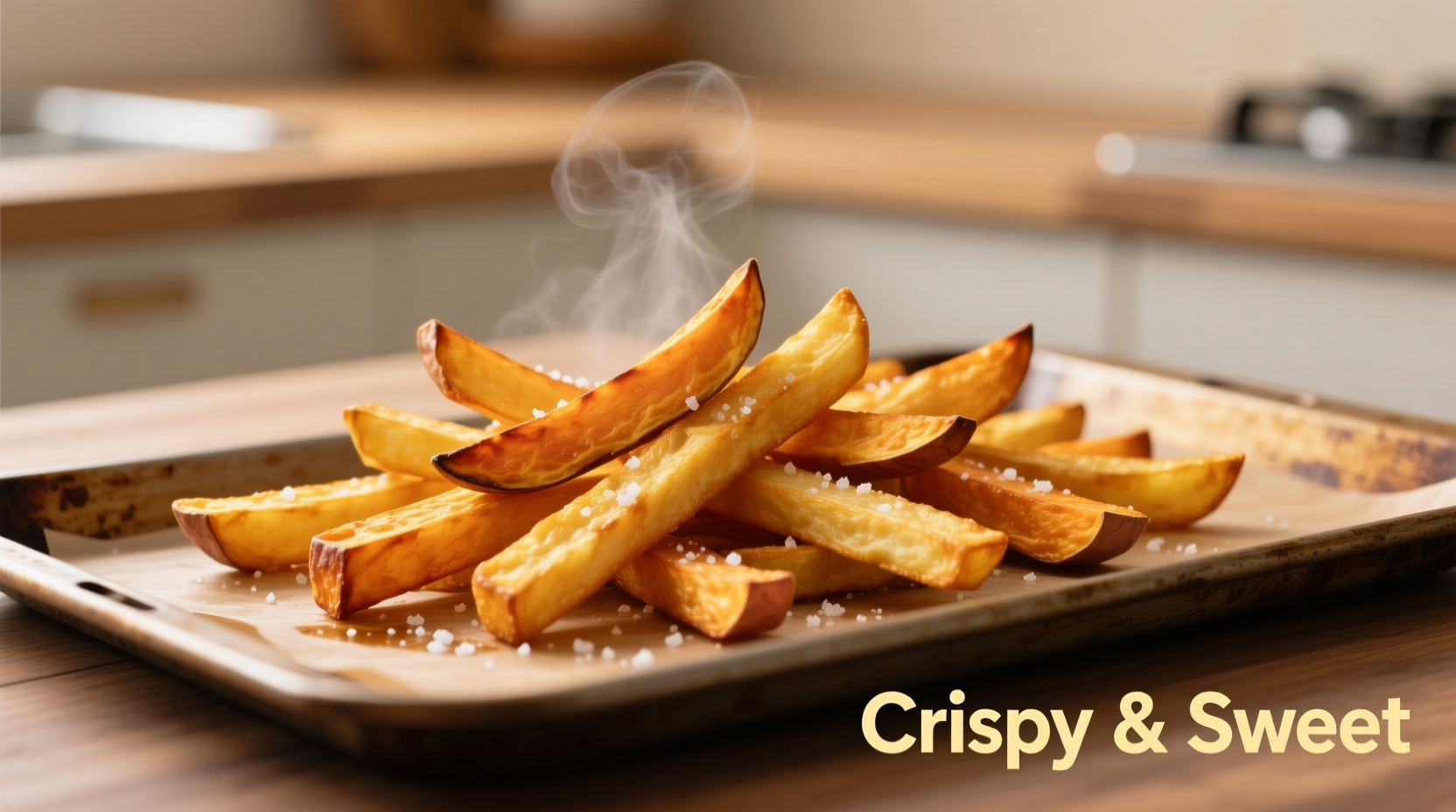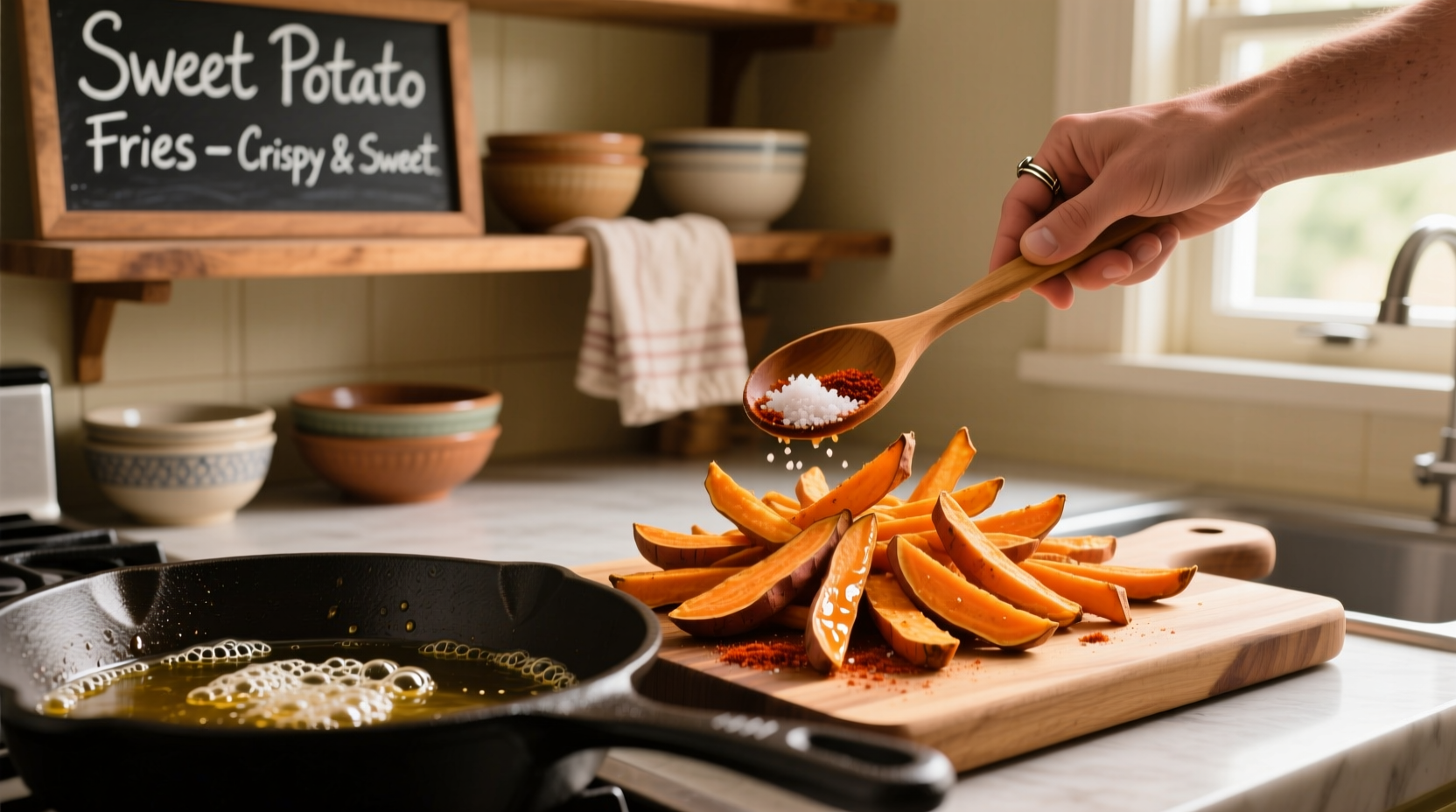Many home cooks struggle with sweet potato fries that turn out soggy, burnt, or unevenly cooked. The secret lies in understanding sweet potatoes' unique starch composition and moisture content. Unlike regular potatoes, sweet potatoes contain more sugar and less starch, which affects how they respond to heat. This guide reveals the professional technique that guarantees consistent results—no special equipment required.
The Science Behind Perfect Sweet Potato Fries
Sweet potatoes behave differently than regular potatoes due to their higher sugar content and different starch structure. When exposed to high heat, the sugars caramelize quickly, often burning before the interior fully cooks. The key is managing moisture content and starch distribution through a simple pre-treatment process.
| Nutrient Comparison (per 100g) | Sweet Potato | Regular Potato |
|---|---|---|
| Carbohydrates | 20.1g | 17.0g |
| Dietary Fiber | 3.0g | 2.2g |
| Sugars | 4.2g | 0.8g |
| Vitamin A | 14187 IU (284% DV) | 2 IU |
Source: USDA FoodData Central (accessed 2023)
This nutritional profile explains why sweet potatoes require different cooking techniques. The higher sugar content means they caramelize faster, while the different starch composition affects how they crisp up. Understanding these differences is crucial for perfect results.
Essential Ingredients & Equipment
You'll need just five simple ingredients and basic kitchen tools:
- 2 large sweet potatoes (about 1.5 lbs / 680g)
- 1.5 tablespoons cornstarch or arrowroot powder
- 1.5 tablespoons olive oil or avocado oil
- 1 teaspoon kosher salt
- Optional: 1/2 teaspoon garlic powder, paprika, or preferred seasoning
Equipment: Sharp chef's knife, cutting board, large bowl, baking sheet, parchment paper, clean kitchen towel or paper towels
Step-by-Step Preparation Guide
1. Proper Cutting Technique
Cut sweet potatoes into uniform 1/4-inch thick sticks. Consistency is critical—varying thickness leads to uneven cooking. Start by trimming ends, then cut lengthwise into 1/4-inch slices. Stack several slices and cut lengthwise again into 1/4-inch sticks.
2. The Critical Soaking Process
Place cut fries in a large bowl of cold water for at least 30 minutes (up to 2 hours). This removes excess surface starch that causes sogginess. For best results, change the water 2-3 times until it runs clear.
3. Thorough Drying Method
This step makes or breaks your results. After soaking, spread fries on a clean kitchen towel and pat completely dry. Any surface moisture will steam the fries instead of allowing them to crisp. For extra insurance, let them air-dry for 10 minutes after patting.

4. Coating for Maximum Crispiness
In a dry bowl, toss dried fries with cornstarch until evenly coated. The cornstarch creates a light barrier that absorbs moisture during baking while promoting crispiness. Add oil and seasonings last, tossing gently to avoid knocking off the cornstarch.
5. Baking for Perfect Results
Preheat oven to 425°F (220°C). Line a baking sheet with parchment paper and arrange fries in a single layer with space between them. Bake for 15 minutes, flip carefully, then bake another 10-15 minutes until golden brown and crispy. Avoid overcrowding—use two baking sheets if necessary.
Troubleshooting Common Problems
Why Your Fries Get Soggy
Sogginess typically occurs from three issues: insufficient soaking time, inadequate drying, or overcrowded baking sheets. The soaking process removes excess starch that would otherwise create a gummy texture. Always change the water until it runs clear and ensure fries are completely dry before coating.
Preventing Burnt Edges
Sweet potatoes' high sugar content causes edges to burn before centers cook through. The solution is precise temperature control—425°F is the sweet spot. Lower temperatures won't crisp properly, while higher temperatures burn the sugars. Flip fries halfway through cooking for even browning.
Variations & Serving Suggestions
Seasoning Options
- Classic: Salt and freshly cracked black pepper
- Spicy: Cayenne pepper, smoked paprika, and garlic powder
- Sweet: Cinnamon and a touch of brown sugar
- Herby: Rosemary, thyme, and garlic
Dipping Sauces
Try these quick homemade dips:
- Chipotle aioli: 1/4 cup mayo + 1 minced chipotle in adobo + 1 tsp lime juice
- Garlic herb yogurt: 1/2 cup Greek yogurt + 1 minced garlic clove + 1 tbsp fresh herbs
- Maple mustard: 2 tbsp Dijon mustard + 1 tbsp pure maple syrup
Storage & Reheating Tips
Store leftovers in an airtight container in the refrigerator for up to 3 days. For best results when reheating:
- Air fryer: 375°F for 3-4 minutes
- Oven: 400°F on a baking sheet for 5-7 minutes
- Avoid microwave: Makes fries soggy
Freezing is not recommended as sweet potatoes lose texture when frozen and thawed.
Contextual Considerations
This method works best with orange-fleshed sweet potatoes (Beauregard or Jewel varieties). Different varieties have varying moisture and sugar content:
- Orange-fleshed (most common): Follow standard instructions
- White-fleshed: Reduce baking time by 3-5 minutes
- Purple-fleshed: Increase cornstarch to 2 tablespoons to counter higher moisture
Altitude affects cooking time—at elevations above 3,000 feet, increase baking time by 5-8 minutes while monitoring closely to prevent burning.











 浙公网安备
33010002000092号
浙公网安备
33010002000092号 浙B2-20120091-4
浙B2-20120091-4